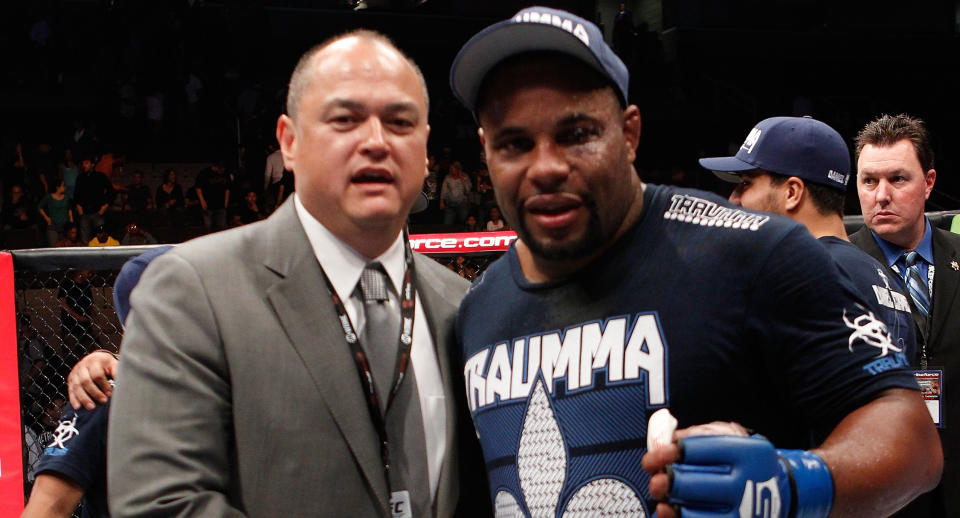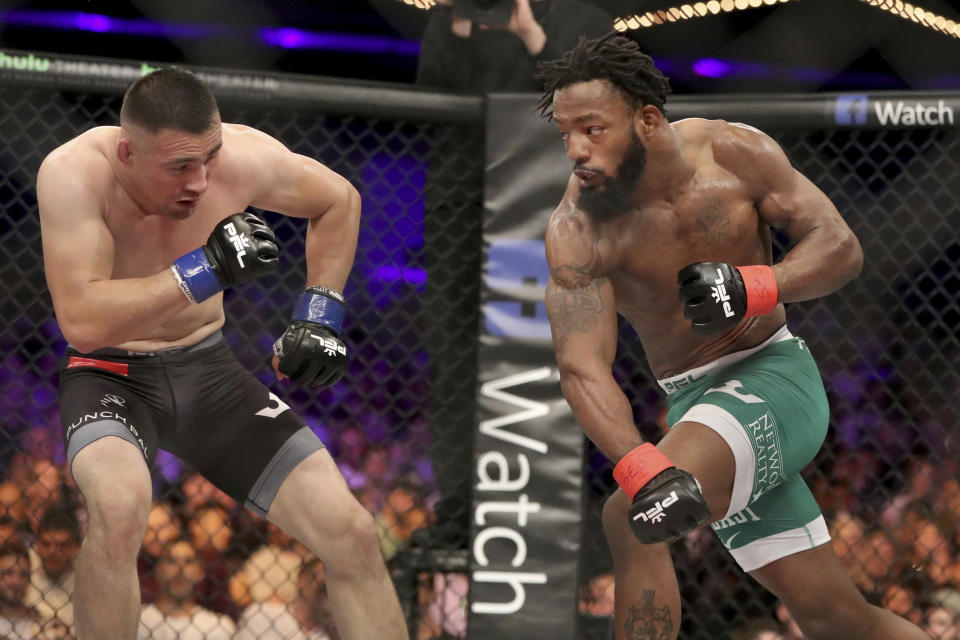Golden age of innovation? 'Contender Series,' Bellator tourneys and PFL carve new MMA path

It’s become an all-too-familiar scene over the past few years, one that has helped lead to a slow-but-steady decline in television ratings: A “UFC Fight Night” on FS1 that seemingly exists for no better reason than to fill hours of programming slots.
A 12-fight card is stretched to the length of a baseball doubleheader, with long studio breaks in between bouts even if a fight finishes in less than a minute; a string of “Fighter A vs. Fighter B” matchups made for no discernible reason; and a main event that would be at best a pay-per-view opening match on another card.
Contrast those long, depressing nights to the frenetic energy of this summer’s second season of “Dana White’s Tuesday Night Contender Series.” The show, which wrapped up last week, is set at the UFC Gym in Las Vegas, as young prospects compete for a chance to be signed by the UFC, with the company’s president offering contracts to those he deems the evening’s most impressive performers.
The premise of the show — which ran on UFC Fight Pass and will move to ESPN+ in 2019 — has made for a critical success. An eye-popping 33 of the 40 total bouts during the season ended in a KO or submission, as competitors do their best to catch White’s eye.
In addition to the furious action, the program simply looks different than the tired Fight Night presentation, and is usually done in two hours, a stark change from FS1’s mediocre marathons that have driven casual fans away.
White, himself, sounds giddy about the show’s future.
“I said this before and I’ll say this again, I could do this every Tuesday,” White told reporters following the season finale. “I love it. And obviously you guys do, too. We have more [media] here than for FS1 fights. The fights are incredible, they’re all good, everyone comes to win, the matchups are incredible. It’s a great show, I love it.”
Contender Series, is by necessity a one-season-per-year phenomenon, as there are only so many top-level prospects to go around. But a look around the sport of mixed martial arts finds this is something of a golden age of innovation, from “Contender Series” to Bellator’s Welterweight Grand Prix to the standings concept of the Professional Fighters League.
Not every idea will stick, but it appears that 25 years into the sport as we knew it, promoters are attempting to evolve MMA in a manner similar to basketball adding the shot clock and the 3-pointer.
And if anyone has developed a well-deserved reputation among promotional circles for being willing to try something new and let it succeed or fail on its own merits, it’s Bellator CEO Scott Coker.
The Northern California native cut his teeth promoting kickboxing before launching the highly regarded Strikeforce MMA promotion in 2006. Coker’s memorable moments include the first MMA event at the Playboy Mansion in Los Angeles in 2007, which streamed live on Yahoo Sports and thus doubled as the first MMA card to live stream on a major mainstream sports website; the 2009 Cris Cyborg vs. Gina Carano fight, in which Coker headlined a major card with women at a time old-school conventional wisdom said you couldn’t put women in a main-event spot (the show drew nearly 14,000 in San Jose and a then-record audience on Showtime); and the legendary 2011 Heavyweight Grand Prix tournament, which launched Daniel Cormier to stardom. The current UFC heavyweight and light heavyweight champion entered the tournament as an alternate and defeated Antonio “Bigfoot” Silva and Josh Barnett to win.

Not everything has struck gold: Coker wishes he could take back the live-event presentation of his Bellator: Dynamite card in San Jose in 2015. By placing a ring and a cage side by side on the arena floor, too many fans were unable to see what was going on at any given time, which led for a dead atmosphere on television.
But you never know what works if you don’t try.
“I’ve always wanted to put on the fights that I want to see, as a fan,” Coker told Yahoo Sports. “I always admired how they do things over in Japan, with a little bit of something for everyone, so maybe there’s something you know you want to see when you go to the fights, and maybe you get exposed to something new that you end up liking, too. When people were saying ‘fans won’t buy tickets for a women’s fight,’ I just saw with my own eyes how big a star Gina had become and what a fighter Cyborg was becoming. Giving them the chance to headline was an easy call.”
Coker’s latest wrinkle will be unveiled in Bellator’s upcoming, eight-man Welterweight Grand Prix, which kicks off Sept. 29 in San Jose. In this tournament, Bellator welterweight champion Rory MacDonald’s belt will be on the line when he meets Jon Fitch in the first-round (date to be determined).
If MacDonald wins, his belt will be on the line throughout the tourney. If Fitch wins, he defends going forward. A tournament that started with MacDonald as champion could end up with MacDonald winning out and staying champ, or could theoretically have as many as four champs if it changes hands in each round.
“With this one, it was a matter of, we have a great roster of welterweight talent, but these tourneys take time and you don’t want to take the belt out of the mix. So, we went to Rory with the idea, and he was fine with things as long as all the fights in the tourney were five rounds to keep things fair. This way, Rory is in the tourney and the belt stays in play the whole time.”
Perhaps no one, though, has gone quite as far in implementing change as the Professional Fighters League, the rebranded World Series of Fighting.
WSOF was a legit promotion, as the success of former WSOF champs Marlon Moraes, David Branch and Justin Gaethje (who is 1-2 but has been a part of three straight Fight of the Year candidates against elite competition) in the UFC attest.
But WSOF never quite made it over the hump in a crowded marketplace during its five-year run. And that’s where PFL CEO Carlos Silva saw an opportunity for something new. Silva comes from a background as an executive with Universal Sports, the cable network that focused on Olympic-style sports such as running, swimming and cycling. And he saw MMA more through an Olympic lens than an old-school fight promotion view.
“I didn’t see a ‘fight promotion,’” Silva told Yahoo Sports. “I saw, specifically, a league for professional athletes and a manner to present them in a professional league in which they can still retain their individuality.”

The PFL, which has been putting on cards on alternating Thursdays this summer, put fighters from six divisions into two-fight regular seasons, with the top eight fighters in each division moving on to single-elimination playoffs later this year. Winners receive points on a sliding scale, with six points for a first-round finish, five for finishing in the second, four for finishing in the third, and three for a decision win. There’s an advertised $1 million prize for each tournament winner; and the winner will be considered the 2018 champion, similar to a major sports team winning a championship, then will start over in 2019, rather than the traditional manner of defending a belt from fight to fight.
In practice, that’s translated into a summer full of exciting fights as competitors go for broke in trying to finish the bouts. While the jury’s out on how this will work over the long haul, PFL has been an artistic and critical success to date, and the company just last week announced $28 million in new funding, with celebrities Kevin Hart, Tony Robbins, Mark Burnett and Washington Capitals owner Ted Leonsis among the investors.
“People are more interested in the fights when they know the fights have real stakes,” said Silva, whose company returns to action Thursday with a card from Atlantic City broadcast live on NBCSN. “Sometimes you see a fighter whose up two rounds and he coasts in the third, you don’t see that here because that one extra point finishing in the third round can make the difference in making the playoffs or not. Fighters are going all-out and the fans are responding.”
We’re about to pivot back into the lame-duck era of the UFC’s Fox broadcast deal. With any luck, TV’s powers-that-be are hearing the fans’ and critics’ response to the fresh ideas that have sprung forth this year. If the end result is more innovation, and less doing things the way they’ve always been done for its own sake, then maybe sitting through these interminable Fight Night cards will eventually mean something after all.
More from Yahoo Sports:
• Dan Wetzel: Is Tiger Woods back?
• Charles Robinson: Broncos may be running out of patience with young QB
• Cubs stun Nationals with one of baseball’s rarest plays
• Jeff Passan: Latest incident proves MLB is still a white man’s game


